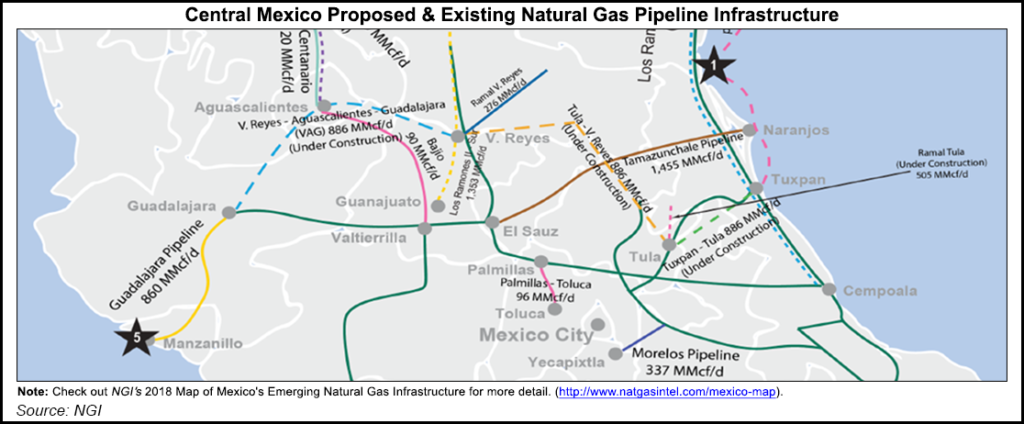Regulatory | Infrastructure | NGI All News Access | NGI Mexico GPI
Update to Mexico Natural Gas Pipeline Safety Rules Slated for Late August
New safety standards for Mexico’s natural gas pipelines, their first update since the 2013-2014 energy reforms, are set to take effect later this year.

The new regulation, NOM-007-ASEA-2016, sets the minimum requirements and technical specifications in industrial, operational and environmental safety standards for gas pipelines in Mexico. The regulations were finalized earlier this year, but won’t enter into force until Aug. 22.
“This new document is an update of the existing framework,” an Asociacion Mexicana de Gas Natural (AMGN) spokesperson told NGI’s Mexico GPI. AMGN is a local industry group of more than 30 companies in the pipeline, marketing and distribution businesses.
The revised norms, which follow national and international industry best practices, reflect technological advances and new engineering practices in the pipeline business, according to the document, published in Mexico’s official gazette in early March.
The rules apply principally to transmission infrastructure such as pipelines, metering and regulator stations, and compressor stations. They also extend to transport networks for ethane and coalbed gas.
The 87-page regulatory document covers all stages in the life cycle of a pipeline, from design and engineering, to construction, to operation and maintenance (O&M), and finally decommissioning.
Among other things, the updated norms increase the number of class locations from four to five. Class locations are a method of assessing safety risks along a pipeline route, based on the number of nearby dwellings and other environmental factors. The new category, Class 1, is for isolated areas with little to no human presence.
Other notable changes include odorization requirements for pipelines under certain circumstances and new regulations for repair work in the field, according to AMGN.
The new safety standards are to replace older regulations dating from 2010, before the historic reforms of the Mexican energy sector got underway.
The new rules will undergo a staggered rollout for pipelines already in-service or under development by the August start date, and they also include exemptions intended to smooth out the transition to the updated regulatory framework.
“The updated norms will apply 100% to new projects that apply for or receive permits after the regulation enters into force,” the AMGN spokesperson said. “For pipes that are already under construction or in-service, they will have to make adjustments at certain stages of the project life cycle, such as operation and maintenance, but not in earlier phases like design and approval.”
For example, after Aug. 22 pipelines in operation will have 60 days to comply with the odorization rules and 180 days for the new O&M standards, but they can continue adhering to the older design and construction norms that would have applied at their original in-service dates.
The existing natural gas pipeline infrastructure includes the 6,350-mile Sistrangas integrated network, which is Mexico’s main transport system, and some 4,000 miles of private pipelines tendered since 2012.
The private pipelines, almost all anchored by state power company Comision Federal de Electricidad (CFE), started to come in-service during 2017, while most of the remaining projects are due to start operating by the end of this year.
The updated pipeline norms were originally written by energy regulator Comision Reguladora de Energia (CRE), but were later transferred to a new agency created as part of the energy reforms.
The Agencia de Seguridad, Energia y Ambiente (ASEA) is charged with regulating and enforcing industrial and environmental safety laws in the hydrocarbons sector. An administrative unit within the Ministry for the Environment and Natural Resources, the ASEA has various oversight responsibilities in the oil and gas industry, including conducting inspections and root cause analyses, issuing fines and ordering shutdowns.
The young agency is headed by Carlos de Regules Ruiz-Funes, a former official at Petroleos Mexicanos (Pemex). In his previous post, de Regules was responsible for environmental safety and planning at the state oil company.
© 2024 Natural Gas Intelligence. All rights reserved.
ISSN © 1532-1231 | ISSN © 2577-9877 | ISSN © 2577-9966 |
